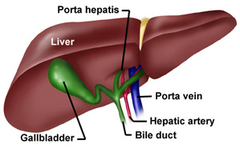Porta hepatis Definition
It refers to a short, deep fissure that stretches in a traverse manner across the bottom section of the left part of the right liver lobe.
It is also referred to as the “Transverse fissure of the liver.”
Porta hepatis Anatomy
It is approximately 5 cm in length. It is almost joined to the left sagittal fossa at right angles.
Porta hepatis Location
It is situated near the posterior surface of the right lobe of the liver.
Porta hepatis Order of Structure
Porta hepatis follows a specific order of structures from its anterior to posterior portion, which is defined by the term “DAVE” that stands for:
- D denotes right and left hepatic ducts
- A denotes right and left hepatic artery
- V denotes portal vein
- E denotes Winslow’s epiploic foramen
Porta hepatis Function
It acts as a gate for various ducts, vessels, and nerves to enter and exit. The hepatic portal system enters the liver through this structure. It also transmits lymphatics and nerves.
The hepatic portal vein and the hepatic artery proper enter it while the common hepatic duct leaves it.
Porta hepatis Pictures
These useful images will give you an idea about the physical appearance of this structure.
Picture 1 – Porta hepatis
Picture 2 – Porta hepatis Image
References:
http://en.wikipedia.org/wiki/Porta_hepatis
http://medical-dictionary.thefreedictionary.com/porta+hepatis
http://www.wisegeek.com/what-is-the-porta-hepatis.htm



No comments yet.